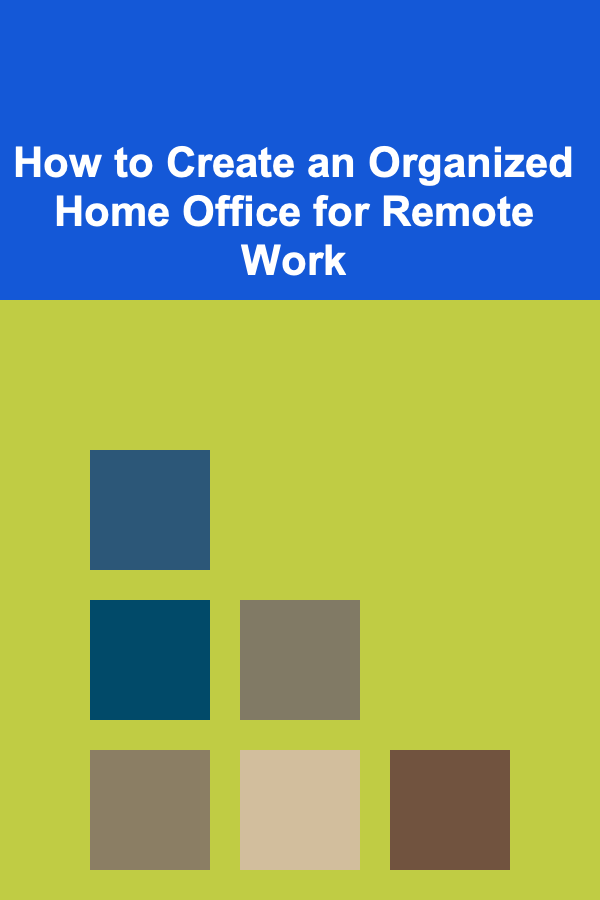
How to Create an Organized Home Office for Remote Work
ebook include PDF & Audio bundle (Micro Guide)
$12.99$10.99
Limited Time Offer! Order within the next:

The rise of remote work has transformed the way we approach our professional lives. While working from home offers flexibility and convenience, it also presents unique challenges---one of which is maintaining an organized and efficient workspace. An organized home office not only enhances productivity but also fosters a sense of professionalism and well-being. This comprehensive guide will delve into the essential steps and strategies for creating an organized home office tailored to your needs, ultimately leading to a more successful remote work experience.
The Importance of an Organized Home Office
1. Enhanced Productivity
An organized workspace minimizes distractions, allowing you to concentrate on tasks at hand. When everything has its designated place, you'll spend less time searching for items and more time focusing on your work.
2. Improved Mental Clarity
Clutter can lead to mental chaos. A tidy environment promotes clarity and reduces stress, enabling you to think more clearly and make better decisions.
3. Professionalism
A well-organized office reflects professionalism, especially if you are frequently engaged in video calls or virtual meetings. Your workspace can communicate your commitment to your work and set a positive tone during interactions.
4. Efficient Use of Space
Remote work often requires maximizing limited space. Organizing your home office allows you to use every inch effectively, ensuring that you have all necessary tools within reach.
5. Better Work-Life Balance
Having a dedicated, organized workspace helps create a psychological boundary between your work and personal life. This separation is crucial for maintaining balance and avoiding burnout.
Step-by-Step Guide to Creating an Organized Home Office
Step 1: Assess Your Needs and Space
a. Determine Your Work Requirements
Consider the nature of your work. Do you need a large desk for multiple screens, or will a small workstation suffice? Identify the tools and equipment you require, such as:
- Computer and peripherals
- Printer and scanner
- Office supplies
- Storage solutions
b. Evaluate Available Space
Examine the area where you plan to set up your home office. Consider factors such as:
- Size: Is the space large enough to accommodate your needs?
- Lighting: Is there sufficient natural light, and how will you supplement it with artificial lighting?
- Noise Level: Are there potential distractions or interruptions in your chosen location?
Step 2: Choose the Right Furniture
a. Select a Functional Desk
Your desk serves as the centerpiece of your workspace. When selecting a desk, consider:
- Size: Ensure it provides ample space for your computer and other necessary items.
- Height: Look for adjustable height options if you prefer standing while working.
- Style: Choose a design that complements your home decor.
b. Invest in an Ergonomic Chair
An ergonomic chair is essential for comfort during long hours of work. Key features to look for include:
- Adjustable height
- Lumbar support
- Comfortable material
Step 3: Organize Your Equipment and Supplies
a. Set Up Technology
Ensure that your technology is properly set up for efficiency. Consider the following:
- Cable Management: Use cable organizers or clips to prevent tangling and clutter.
- Placement of Devices: Position your monitor at eye level to promote good posture.
- Backup Systems: Implement reliable backup solutions for data, including cloud storage or external hard drives.
b. Stock Essential Supplies
Gather essential office supplies to ensure your workspace is fully equipped. Common items include:
- Pens and pencils
- Notepads and sticky notes
- Folders and binders
- Stapler and paper clips
Step 4: Create an Effective Storage System
a. Utilize Vertical Space
Maximize your vertical space by incorporating shelves or wall organizers. Consider:
- Floating Shelves: These save floor space while providing additional storage.
- Pegboards: Ideal for customizing tool and supply storage based on your needs.
b. Invest in Organizational Tools
Choose organizational tools that fit your style and needs, such as:
- Drawer Organizers: Keep smaller items organized and easily accessible.
- Storage Bins: Use labeled bins to store infrequently used items or seasonal supplies.
- File Cabinets: Essential for organizing important documents securely.
c. Declutter Regularly
Set a routine for decluttering your workspace. Schedule periodic clean-ups to remove unnecessary items or outdated materials. A clean slate fosters productivity.
Step 5: Personalize Your Workspace
a. Add Inspiring Decor
Incorporate personal touches that reflect your personality and inspire creativity. Consider:
- Artwork or prints that resonate with you
- Plants to add freshness and improve air quality
- Motivational quotes displayed prominently
b. Optimize Comfort
Make your office comfortable by including elements like:
- Cozy blankets or throws for colder days
- Stress-relief items, such as stress balls or fidget toys
- Aromatherapy diffusers or scented candles for a calming atmosphere
Step 6: Establish a Routine
a. Set Work Hours
Define specific work hours to create a sense of structure. Communicate these hours to family members or housemates to minimize interruptions.
b. Develop a Morning Ritual
Start your workday with a consistent morning routine. This may include:
- A healthy breakfast
- Short exercise or stretching
- Reviewing your daily goals
c. Take Regular Breaks
Incorporate regular breaks into your schedule to avoid burnout and maintain focus. Consider techniques such as:
- The Pomodoro Technique: Work for 25 minutes, then take a 5-minute break.
- Stretching or walking around to refresh your mind.
Step 7: Leverage Digital Organization
a. Use Digital Tools
Embrace digital solutions for task management and organization. Popular tools include:
- Project Management Software: Tools like Trello or Asana help keep track of projects and deadlines.
- Digital Note-Taking Apps: Applications like Evernote or Microsoft OneNote allow you to organize ideas and information efficiently.
b. Maintain a Clean Desktop
Just as a physical workspace should be organized, so too should your digital workspace. Implement the following practices:
- Regularly delete unnecessary files and applications.
- Organize files into clearly labeled folders.
- Back up important data regularly.
Step 8: Create a Communication Hub
a. Set Up Communication Tools
For effective collaboration with colleagues, establish a communication hub that includes:
- Video Conferencing Software: Tools like Zoom or Microsoft Teams for virtual meetings.
- Instant Messaging Platforms: Slack or Microsoft Teams facilitate quick and easy communication.
b. Designate a Meeting Area
If possible, create a designated space for virtual meetings. Ensure this area is visually appealing and free from distractions.
Step 9: Evaluate and Adjust
a. Seek Feedback
Regularly evaluate your workspace and seek feedback from colleagues or family members. Ask for input on ways to improve your setup.
b. Stay Flexible
Be willing to adjust your workspace as needed. As your work evolves, so too should your organization strategies. Don't hesitate to try new arrangements or tools if they enhance your productivity.
Step 10: Maintain Work-Life Balance
a. Define Boundaries
Establish clear boundaries between work and personal life. Use physical cues, like closing your office door at the end of the day, to signal work time is over.
b. Prioritize Self-Care
Make self-care a priority. Engage in activities that recharge you, whether that's exercise, hobbies, or spending time with loved ones.
Advanced Tips for Optimizing Your Home Office
1. Utilize Smart Technology
Consider integrating smart technology into your office setup. Smart devices can automate tasks such as adjusting lighting or controlling temperature, enhancing comfort and productivity.
2. Experiment with Layouts
Different layouts can impact productivity. Experiment with various desk placements, seating options, and equipment arrangements to find what works best for you.
3. Create a Vision Board
A vision board can serve as a source of inspiration. Include professional and personal goals, images, and quotes that motivate you to stay focused on your objectives.
4. Collaborate with Others
If working remotely with others, consider setting up shared workspaces or utilizing co-working spaces occasionally. Collaboration and social interaction can boost motivation and creativity.
5. Attend Virtual Workshops
Invest in your professional development by attending online workshops or courses. Continuous learning can stimulate creativity and enhance skills relevant to your work.
Overcoming Common Challenges in Home Office Organization
1. Distractions from Home Life
Challenge: Family members, pets, and household chores can distract you during work hours.
Solution: Set clear boundaries and communicate your work schedule to those in your household. Use noise-canceling headphones or white noise machines to minimize distractions.
2. Lack of Space
Challenge: Limited space can hinder your ability to create an organized office.
Solution: Optimize available space by using multifunctional furniture and vertical storage solutions. Compact, portable desks can also provide flexibility in smaller environments.
3. Difficulty Staying Motivated
Challenge: Working from home can sometimes lead to decreased motivation.
Solution: Establish a structured routine and set specific goals. Break tasks into smaller, manageable pieces to alleviate feelings of overwhelm.
4. Procrastination
Challenge: The comfort of home may encourage procrastination.
Solution: Use techniques like the Pomodoro Technique or time-blocking to reinforce focus and accountability.
5. Technological Issues
Challenge: Technical difficulties can disrupt workflow.
Solution: Invest in reliable technology and consider backups for critical equipment. Keep a list of tech support resources handy for quick troubleshooting.
The Long-Term Benefits of an Organized Home Office
1. Increased Efficiency
An organized office enables smoother workflow, leading to greater efficiency and productivity. You'll complete tasks faster and with less frustration.
2. Better Job Satisfaction
Creating an inviting and functional workspace contributes to job satisfaction. A comfortable environment fosters creativity and makes work feel more enjoyable.
3. Professional Growth
With a well-organized office, you'll be better positioned to pursue professional development opportunities. An efficient workspace allows you to invest time in skill enhancement and career advancement.
4. Lasting Work Habits
The habits you develop in an organized workspace can translate to other areas of your life, promoting overall organization and discipline.
5. Positive Impact on Well-Being
A well-structured workspace contributes to improved mental health and well-being. Reducing stress and clutter creates a more balanced lifestyle, enhancing both personal and professional fulfillment.
Conclusion
Creating an organized home office is a vital step for anyone engaged in remote work. By investing time and effort into establishing an efficient, functional workspace, you set yourself up for success---enhancing productivity, reducing stress, and fostering a positive work-life balance.
By following the outlined steps, you can tailor your home office to meet your specific needs while maintaining an organized environment. Remember, organization is a continuous process; be willing to adapt and refine your setup as your work evolves.
Ultimately, a well-organized home office not only supports your professional endeavors but also enriches your overall quality of life. Embrace the journey toward a more organized workspace, and enjoy the benefits it brings to your remote work experience.
Reading More From Our Other Websites
- [Soap Making Tip 101] Safety First: How to Select and Maintain Soap-Making Equipment Properly
- [Organization Tip 101] How to Create a Fun and Interactive Time Capsule Experience
- [Personal Financial Planning 101] How to Create a Will and Estate Plan for Your Family's Future
- [Polymer Clay Modeling Tip 101] Brittle or Soft? How to Diagnose and Fix Common Polymer Clay Texture Issues
- [Home Lighting 101] How to Use Smart Lighting to Save Energy and Enhance Security
- [Survival Kit 101] How to Assemble a High‑Tech Survival Kit for Drone Operators in Remote Locations
- [Biking 101] The Ultimate Guide to Cyclocross: Bike Setup, Training, and Tips
- [Personal Investment 101] How to Use Robo-Advisors for Hands-Off Investment Management
- [Home Budget 101] How to Master Budgeting for a New Job: Setting Yourself Up for Financial Success
- [Personal Finance Management 101] How to Simplify Debt Consolidation and Improve Your Financial Health

How to Build a Checklist for Quality Assurance After Website Content Migration
Read More
How to Make Extra Money by Auditing Websites from Home
Read More
How to Set Up a Checklist for Creating an Event Budget for Fundraising
Read More
How to Lead Diverse Teams Effectively
Read More
10 Tips for a Luxurious Picnic Experience
Read More
10 Simple Community Service To-Do List Ideas for Busy Adults
Read MoreOther Products

How to Build a Checklist for Quality Assurance After Website Content Migration
Read More
How to Make Extra Money by Auditing Websites from Home
Read More
How to Set Up a Checklist for Creating an Event Budget for Fundraising
Read More
How to Lead Diverse Teams Effectively
Read More
10 Tips for a Luxurious Picnic Experience
Read More